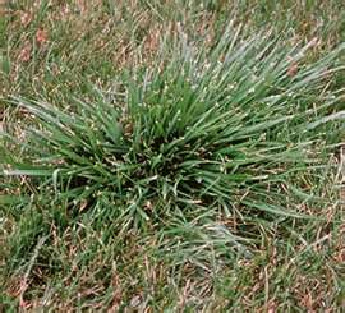Tall Fescue
 Tall fescue is an unsightly, objectionable plant which frequently invades turf grass areas; it is often referred to as “bunch grass” because of the scattered tall clumps which appear above the more desirable grass in bluegrass lawns. This grass is often confused by home owners as crabgrass. Tall Fescue cannot be controlled with spring pre-emergent applications.
Tall fescue is an unsightly, objectionable plant which frequently invades turf grass areas; it is often referred to as “bunch grass” because of the scattered tall clumps which appear above the more desirable grass in bluegrass lawns. This grass is often confused by home owners as crabgrass. Tall Fescue cannot be controlled with spring pre-emergent applications.
The Plant:
Tall fescue is a very coarse perennial bunch grass. The leaf veins are very fibrous. When mowed, fibers show on the cut edge, especially if mower blades are not well- sharpened. Mature leaf blades are about 1/2″ wide; ribbed above and smooth below. The lower portions of the stems are reddish-purple, particularly in the spring and fall. Tall fescue invades lawns due to a number of reasons. The primary factor is poor soil preparation during initial planting which allows the weed grass seeds to germinate. Low mowing height and stressed, thin turf also allows tall fescue to invade turf areas.
Practices for Control:
Because tall fescue is a grass, care must be taken when trying to control it in the lawn area, so that adjacent desirable grass is not damaged.
1. Proper fertilization in the lawn can help keep desirable grasses thick and healthy. Tall fescue is not easily established in a well-maintained lawn.
2. Tall fescue can be best controlled by spot-treating with a nonselective herbicide such as Roundup. This kills the whole plant, including the root system. (Because nonselective herbicides will kill any plant they contact including desirable grass plants-extreme care must be used in applying this control.) After tall fescue has died out, treated areas will need to be reseeded or re-sodded.
Cultural Practices for Control:
1. Digging out the areas of tall fescue is an optional method of control. This method often fails due to root fibers left behind. For best results, remove as much of the root system as possible. Bare areas left behind should be reseeded or resodded afterwards.
2. Maintain a 2″ to 3″ mowing height throughout the season to allow desirable lawn grasses to compete more successfully with tall fescue.
The Green Pointe staff is always ready to assist you with your lawn. Please call if we may provide any information to enhance your lawn’s health or appearance.
Please call our office if you have any questions or visit our “Questions” page to review other frequently asked questions and answers. (801) 261-1171
 Green Pointe Lawn Care
Green Pointe Lawn Care